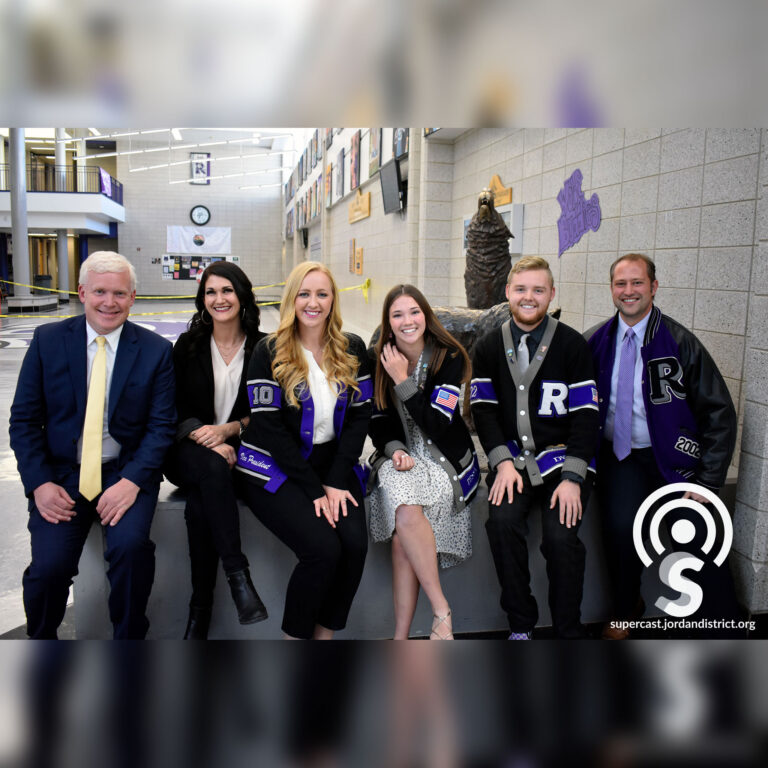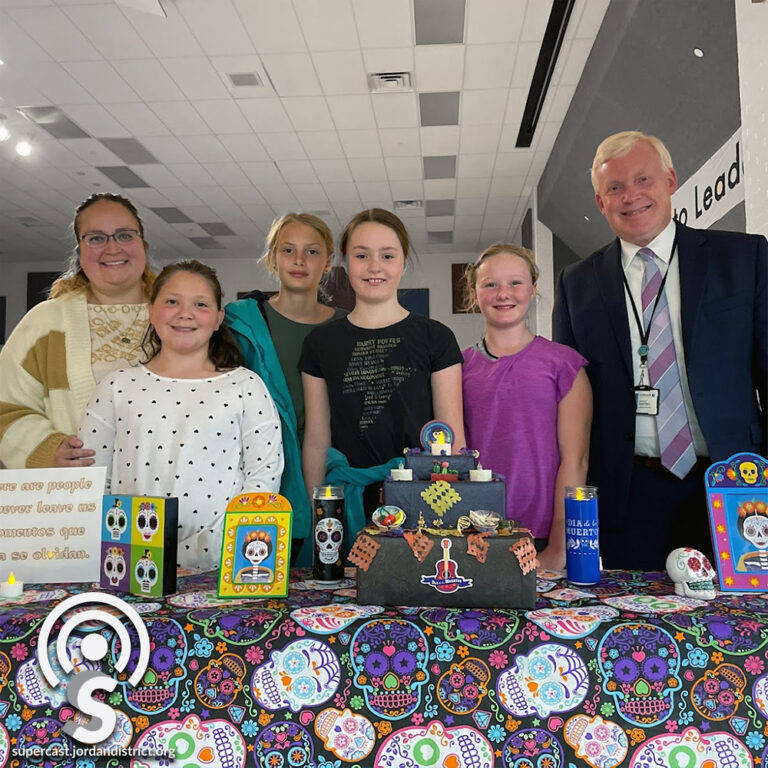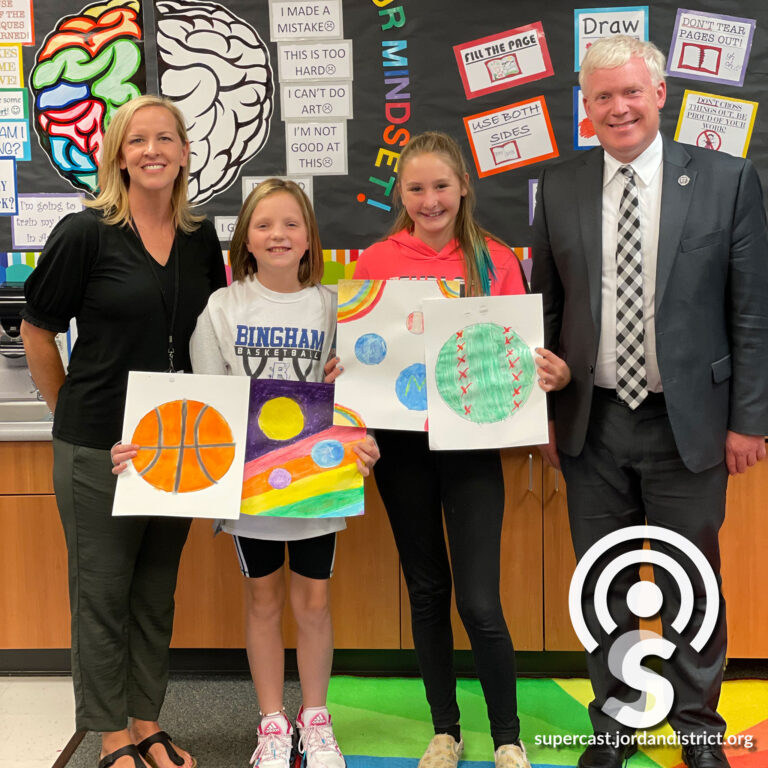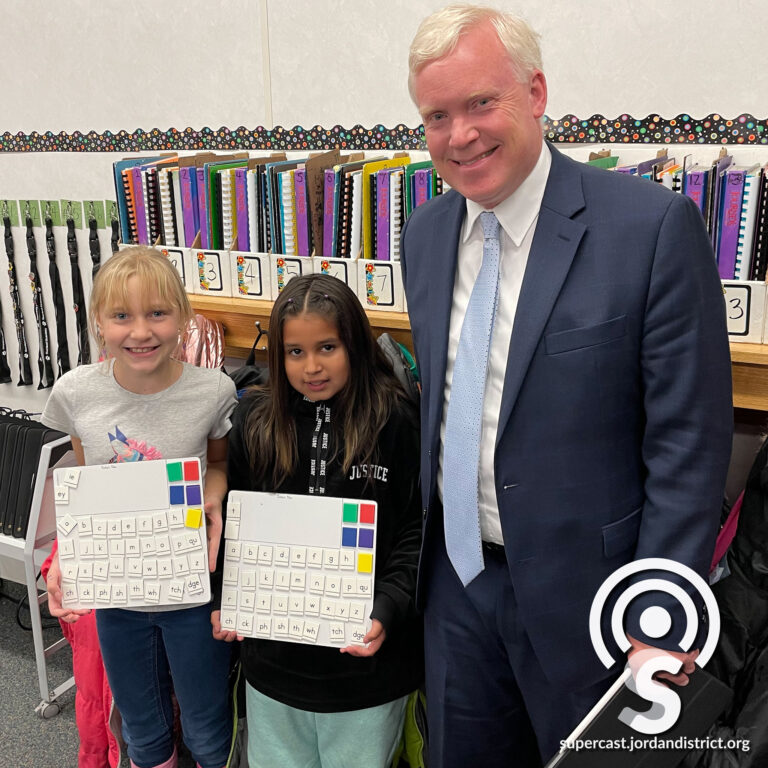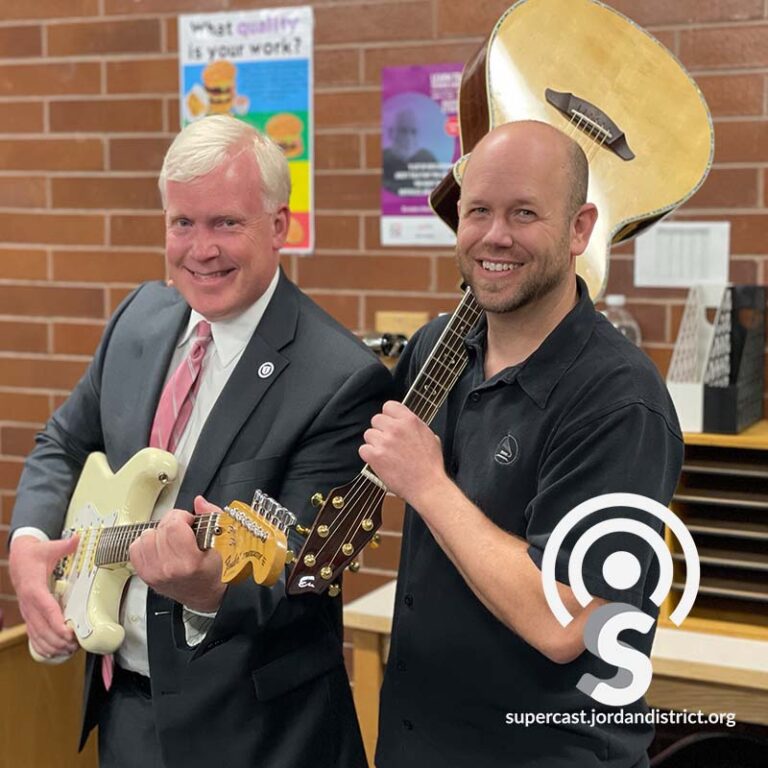They call themselves the “Silverwolf Caucus.” Three former Riverton High School students who are all now public servants, after being elected to the Utah State Legislature.
On this episode of the Supercast, State Representatives Candice Pierucci, Ashlee Matthews, and Jordan Teuscher return to Riverton High for the first time since they graduated. Find out what they learned from their time as students, what advice they have for some student body leaders and why Riverton High is still near and dear to them today.
Stay tuned for a bonus episode on the Silverwolf Caucus tomorrow.
Audio Transcription
Anthony Godfrey:
Hello and welcome to the Supercast. I’m your host, Superintendent Anthony Godfrey. They call themselves the Silverwolf Caucus. These three former Riverton High School students are all now Representatives in the Utah State Legislature. On this episode of the Supercast, State Representatives, Candice Pierucci, Ashlee Matthews and Jordan Teuscher returned to Riverton High for the first time, since they graduated, find out what they learned from their time as students, what advice they have for current student body officers and why Riverton High is still near and dear to them today.
We are here at Riverton High School with what we are calling the Silverwolf Caucus. We have three of our State Representatives here who are former students here at Riverton High. I'm going to let each of them introduce themselves. And we have a couple of members of our current student government here as well to ask you some questions, but let's start out with introductions
Candice Pierucci:
I’m Representative Candice Pierucci and I graduated class of 2010.
Ashlee Matthews:
I'm Representative Ashlee Matthews and I graduated in 2004.
Jordan Teuscher:
I’m Representative Jordan Teuscher. I graduated class of 2002. So 2002.
Anthony Godfrey:
Time flies, time flies.
Jordan Teuscher:
I forgot how we say that.
Anthony Godfrey:
You brought some swag with you. I see you have some memorabilia from when you were here. Representative Pierucci, show me what you have there.
Candice Pierucci:
Well, I lettered in academics and I was FBLA’s Vice-President.
Anthony Godfrey:
Let’s lay it down on the table here, let’s see that.
Candice Pierucci:
Well, it’s been at the bottom of the memory box so I can't promise that it doesn't have fuzzy things on it. I've taken off all my pins and then I was Sterling Scholar for Social Studies.
Anthony Godfrey:
Wow, Sterling Scholar for Social Studies. Vice-President, that is very cool. Very cool. Does this look familiar?
Candice Pierucci:
These things don't ever change. They’re timeless. Taxes, death and your letterman jacket. Those are all the same.
Anthony Godfrey:
Representative Teuscher. I must mention, changed flights, missed some major events and came right from the airport to be part of this. So thanks to all three of you for going to the effort of making this work in your schedule. I know you're very, very busy.
Jordan Teuscher:
I wouldn't miss it. You know, we all love Riverton High School and I wanted to be here for this. So yes, I have my letterman jacket right here. Haven't worn it in a little while, but it looks good. It's warm and nice.
Candice Pierucci:
What did you letter in?
Jordan Teuscher:
I lettered in debate. Yep. So I was a National Debater here and then French, and Seminary. Which is kind of awesome.
Anthony Godfrey:
That's really great. You know, yours says 2002, mine is from the 1900s. So at least it's recent in my book. That's awesome. So now we're going to have our current student officers introduce themselves.
Dylan:
I'm Dylan. I'm the Student Body President here.
Tessa:
I’m Tessa. I’m Artist SBO.
Anthony Godfrey:
Dylan, Tessa, what is your first reaction sitting across from three State Representatives who used to be in your shoes?
Dylan:
I think it's awesome. And I think it shows that Silverwolves can produce such highly esteemed people. It’s almost like a flexing moment for all of us. They’re Silverwolves.
Anthony Godfrey:
It's a good flex for Riverton High. I don't know that there's another high school that can claim three current state representatives.
Candice Pierucci:
I was not aware of any in the legislature right now that have this many. Maybe rural Utah can pull out a couple, but not this many.
Ashlee Matthews:
Well, if they are, they're not saying anything.
Anthony Godfrey:
You got to represent, that's right.
Jordan Teuscher:
I’m just doing the quick math here. We’ve got 75 representatives. So 3 out of the 75, that's 4% of the entire House is a Silverwolf. I think proportionally speaking, we’re punching above our weight.
Anthony Godfrey:
4% came through this building, that's no small matter. That's a big deal.
Jordan Teuscher:
We have some open seats coming out so we’ll just need to find some more Silverwolves.
Ashlee Matthews:
The most important question we will ask any candidate is, are you a Silverwolf?
Anthony Godfrey:
It’s about growing the Silverwolf Caucus, that’s the important thing. Tell me what questions do you have for our State Representatives?
Dylan:
My first one is like, what's the biggest thing, or what thing do you notice the most that's like, you're still a Silverwolf? What reminds you the most? Like, you'll do something in your day and you're like, ah, that's because I'm a Silverwolf
Candice Pierucci:
For me, when I think of high school, I think of the community and I feel like it lays the foundation for a lot of students on thinking you can do anything in life. When I think back on high school, I wish I could tell young Candice not to stress so much, but maybe it was good I did. Because then I tried to achieve a lot of things. Just the sense of friendship that carries with you that obviously we immediately all feel some camaraderieship because of that. Also the awesome teachers here, who you still want to check the board and see how many of them are here, but there are a lot of life lessons and fond memories as you walk through these doors that kind of takes you back.
Ashlee Matthews:
It's true. I'm not even going to try to top that because you said what I was thinking only way better.
Jordan Teuscher:
I'll tell you my thought. I started here in 2000, so this was the first year it opened. So I was a sophomore, it was brand new. We were trying to decide what are the traditions that we need to have. What will actually unite us as a school? Because we had people coming from all different high schools, Copper Hills High School, Bingham High School, that may have had some allegiances there, but we wanted to start off great. So I harken back to that anytime I have a new project, it just reminds me of that idea of coming fresh into a new school, wanting to have good traditions, wanting to get off on the right foot.
Candice Pierucci:
That's crazy because I was here in 2010, which was the year before it split off to go to Herriman High. It was like, everything was one last time that we were all going to be together. So Silver Rush was huge. I remember the One Last Dance theme and it was just really cool. I think high school is terrifying for a lot of people, right? You build relationships with people that you'll never forget. I still am best friends with my high school friends and we keep tabs on each other. So it's really cool, the memories you make.
Ashlee Matthews:
I have something that's not deep or philosophical, like either of them, but I grew up in the neighborhood. We are just right behind the football stadium. So listening to the band practice and every Friday night listening to the announcers, the football game. Where I live now, I live just down the street from my community's high school, and I will say that every time I hear the band practicing it takes me back.
Anthony Godfrey:
There is something about the lights, the crisp air, hearing that ratatat, and the announcer is pretty exciting.
Ashlee Matthews:
It's the last time it's socially acceptable to really paint your face. It’s awesome, I definitely painted my face.
Anthony Godfrey:
There’s license to do some things that you can't later in life.
Ashlee Matthews:
Exactly.
Anthony Godfrey:
Stay tuned. When we come back, find out more about how Riverton High School helped prepare these three legislators for public service.
Break:
Do you simply love learning online? We can't wait to have you join the amazing teachers in our brand new Jordan Virtual Learning Academy. In Jordan Virtual Learning Academy schools, we offer innovative, fun and flexible online learning with daily, real-time instruction from teachers. Enrollment is currently open for all K-12 students in Utah. Start on the path to personalized virtual learning success now at http://connect.jordandistrict.org. That’s connect.jordandistrict.org.
Anthony Godfrey:
We have Principal Carolyn Gough here with I think a few additions to the swag that you brought.
Carolyn Gough:
We do offer a yearly pin so that you can take advantage of the pin that we have for this year. And then this, because you mentioned that Silver Rush was such an integral part of your experience, we have our jug or Silver Rush jug pins. So we wanted to present you with those just as a token of our appreciation for the service that you give.
Dylan:
And a shirt that says ‘Riverton Pride of the Pack”.
Legislators:
Thank you!
Carolyn Gough:
Thanks for representing us so well. If you could wear that in a session, that would be great.
Tessa:
What was like your thing in high school? Like we have student government, like, what was your thing and how did it prepare you for the position you have now?
Ashlee Matthews:
I was on the newspaper staff, and that was my thing. I'm an observer, I'm a watcher, I'm a listener. I just kind of learn by watching and listening to other people, which was very helpful going into this. I had no idea what I was walking into. So I spend a lot of time just taking mental notes and watching and listening to things that are going on. On that same token, talking about relationships and such, I have a very good relationship with the former newspaper adviser, April Squires. She's amazing. We still talk to her all the time and she tells me every time like, ‘oh, you were my favorite life editor.’ I'm sure she tells that to everybody.
Anthony Godfrey:
Life editor, was it the Riverton Life? Is that what it was called?
Ashlee Matthews:
No, Silver Scribe. No, just the life page.
Candice Pierucci:
For me, I did Peer Leadership Team, the National Honor Society. I did the FBLA, Future Business Leaders of America and I did Acapella, but really loved my experience there. Also, my senior year I did an internship at the state Capitol, which totally changed my trajectory. I also did the We the People competition. My teacher advisor was Jenicee Jacobson who I still am in touch with. That internship at the Capitol changed my life. That's where I decided I wanted to do something in government to make a difference. So it was really, really instrumental, I feel like, in me getting here.
Jordan Teuscher:
I mentioned it before, debate. I mean, I was involved in a lot of different things, but that was definitely kind of the hallmark of what I focused my time in most. Little known fact probably for most people here, but debate was the first trophy that Riverton actually won. We had a whole trophy case out here and nothing in it and it was great to be able to put something in the middle. We kept adding to it, adding to it. Over the years, we kind of had to fight with football and cheer and other people that wanted to kind of move debate to the side, said this is more for athletics, but we enjoyed it. We actually competed really well and had a great program.
Anthony Godfrey:
What would you say to current high school students who are maybe considering whether they could or should get involved in politics down the line?
Jordan Teuscher:
I'll say, you know, a lot of my political interest started when I was in high school. It was getting involved in an AP Political Science class, learning about the system and getting challenged to show up to a caucus meeting and it was a scary type thing. So I think that's the biggest advice that I can give to any high schoolers, get involved. I mean, especially at this age there's there's clubs and classes, and even just coming up to the Capitol and spending some time with your elected official, to just learn how the process happens, that will put you in a really good situation in the future to be able to jump into public service when the opportunity presents itself.
Candice Pierucci:
I would say half of the effort you need to be involved is just showing up. So I would encourage students to start getting engaged now and actually take your government course seriously. If you can jump on a campaign, there's no minimum age to help on a campaign, and knock doors or deliver flyers. I'd say, definitely reach out to one of us about doing an internship. If you're a senior, we can always try and pull some strings to get you up there for a fellow Silverwolf. Also not letting your age stop you. As you can see we're all millennials up here, for those of you who are listening. We're all millennials and having different age groups provides different perspectives and diversity in the Legislature that I think is really helpful. So I'd say jump on in and don't hold back.
Ashlee Matthews:
On that same token, but a different way, I agree with Candice, don't let your age hold you back. I was not involved politically at all until, until I ran for office. So, it was weird and it was scary and it was exciting starting something that I had absolutely zero experience in. So I did it and I, and I think everybody else should do it too.
Dylan:
So what do you guys think the state of politics is today and how can we work together to be better?
Candice Pierucci:
I think we have to learn again as a culture, as a society to disagree civilly. I think it starts in AP Government when people start formulating opinions and you get to be able to share your own and realize that just because someone disagrees with you doesn't mean they're evil. It just means they have a different opinion. I feel like I've developed a great friendship with Ashlee who sits across the ideological aisle. But my goodness, apart from being legislators and a Republican and Democrat, we're both moms and friends and able to talk about things that we all care about. I think we have to do a better job of getting off social media, getting out of our echo chambers and learning to interact with people, and learning to meet them as people before we do their ideology. It makes the negotiating process that much better because you're able to find common ground on what you can agree on, which is the best way to create policy.
Jordan Teuscher:
Yeah. I think Candice hit the nail on the head. It's all about finding people that you disagree with and having those conversations. Too much today, people either are afraid to have the conversation or they're being told not to, right. They're saying, you know, we need to alienate ourselves from those people who are across the aisle, who may believe differently than we do. So the more that we can reach out to people who have different opinions and have the discussion and try to understand why they believe that way and not necessarily try to change their opinion, but just seek to understand, we’ll be in a much better spot.
Ashlee Matthews:
For me, the biggest struggle that I had, I guess starting, is just making sure to always keep the people separate from the work. Because, like Candice said, from a political standpoint, I feel like all three of us are in very, very different places. But as people we are, like you said, we have way more in common than not. So it's easier to not take things personally, right. If they disagree with something that I say, if they voted against the bill, I don't think that personally, because I know that it's not intended to be personal. We can leave from a discussion where we disagree with everything and we can say, ‘Oh, dang. Oh, I saw that picture of you on Facebook and Oh wow! Your kids are so cute. Oh, what are you doing for Halloween?’
Dylan:
That kind of reminded me of something, so I want to ask a question. We recently asked a bunch of people, why is Silver Rush your favorite thing? Or why do you think Riverton has a thing? And they said, it's because like everyone forgets who they are and they just become one. They get along with everyone. Do you think there's some part of Silver Rush that helps you to build that assessment as you go further. You've seen that for three years in the month of December, everyone's one group body and their Silverwolf is what makes them the same. Do you think that has affected in a positive way, the rest of your lives?
Candice Pierucci:
Yeah. I have a distinct memory of when we're knocking doors, it was snowing. We were flipping cold, but we were having so much fun. I remember I was with the SBO president. I was with a drama student, there was a football player and a wrestling player. When else in high school, other than at lunch, when you bump into each other, are you all thrown together for the same cause and how much fun we had. You got to know people at a different level. And especially when you're performing right, you're performing tasks or jobs or shoveling snow. At that point, all your labels just drop to the ground and you're just people. So I definitely think that's a big lesson. I think our country has had those moments, not to extrapolate this, but if you think about World War II or getting a man on the moon, we have moments where we let labels fall and we all get together. I think that's when our country's at its best. And that's when Riverton High is at it’s best. There's a difference in the air. I remember walking around just feeling lighter during Silver Rush. I feel like a lot of people feel that way.
Ashlee Matthews:
It carries with you too. You can take that forever. None of us have been here for a very long time, but you asked us what our favorite thing was, and I think we all said Silver Rush was our favorite thing. The thing that we miss most, and when we were the happiest and most proud of being here and you won't forget, you won't forget that feeling.
Anthony Godfrey:
Thanks for joining us on another episode of the Supercast. Join us tomorrow for a bonus episode featuring the Silverwolf Caucus. And remember education is the most important thing you'll do today. We'll see you out there.

